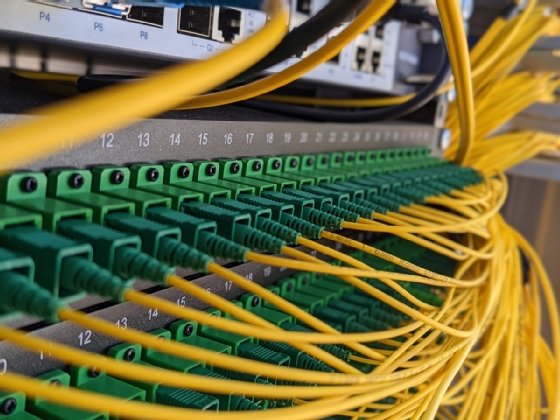patch panel
What is a patch panel?
A patch panel in a local area network (LAN) is a mounted hardware assembly that contains ports that are used to connect and manage incoming and outgoing LAN cables. A patch panel provides a way to keep large numbers of cables organized, enabling flexible connectivity into network hardware located in a data center or an access or wiring closet.
The most common type of patch panel is used within an organization's LAN. Panels can be mounted within industry standard 19-inch or 23-inch racks. The patch panel hardware assembly contains blank ports on one side and a termination point on the other. Cables running throughout a building or campus can be terminated, labeled and then patched into network or audiovisual (AV) hardware. Patch panels are also referred to as patch bays, patch fields or jack fields. In addition to being used within enterprise LANs, patch panels are also commonly used in the legacy voice, radio and television fields.
How do patch panels work?
Patch panel ports are configured to accommodate twisted-pair copper, fiber optic or coaxial cables in a data center or wiring closet. In an enterprise network, a patch panel serves as a sort of static switchboard, using cables to interconnect network computers within a LAN and to outside lines, including the internet or other wide area networks. For twisted-pair Ethernet connections, the patch panels use RJ-45 interconnects.
In facilities that require cable or satellite television hookups with centralized control, coax patch panels are used to centrally feed television sets throughout large portions of a building. For legacy voice communications, such as analog fax machines, two- or four-wire patch panels using RJ-11 interconnects are typically used.
A patch panel uses a patch cord, a sort of jumper cable, to create each interconnection between the terminated patch panel and the network device, such as an Ethernet switch, router or firewall. The patch panel makes it easy to rearrange circuits and devices by moving the patch cables between network devices. Enterprises and other organizations often place patch panels in wiring closets, which are small rooms where networking and other electrical connections are made.
Patch panels are usually mounted into network racks, either above or below network switches. They typically use 1U to 2U of rack space; 1U is equivalent to 1.75 inches of vertical space on the rack. Patch cords connect the patch panel ports to ports in the network switch, voice private branch exchange or digital AV mixers, which creates permanent port connections to the switch that will not be interrupted during moves, adds and changes (MACs).

Types of patch panels
Patch panels can be categorized by the number of ports they contain, with 48-port, 24-port and 12-port panels being among the most common. The most common types of patch panels are the following:
- Twisted-pair copper. These panels are designed for specific twisted-pair copper specifications, like Cat5E, Cat6, Cat6A and Cat7 cables. Because these specifications use slightly different gauges of copper wiring, it is important to pay attention to the cabling that is running to the wiring closet or data center and use the proper specification of patch panel to match it. There are specific patch panels for unshielded twisted-pair (UTP) and shielded twisted-pair cables, depending on the type of environment the network is operating in. For typical office environments, UTP is used. If, however, the operating environment is in a manufacturing plant with higher levels of electromagnetic interference, shielded cabling helps protect against any external interference that can adversely affect the operation of the link. RJ-45 jacks are used to terminate Ethernet-based connections, while RJ-11, RJ-14 and RJ-25 are commonly used for legacy voice devices.
- Fiber optics. Patch panels are available for both single- and multimode fiber cabling. Depending on the age of the installed fiber, the patch panel connector type could be any of the following:
- LC (Lucent Connector or little connector);
- SC (subscriber connector);
- ST (straight tip);
- FC (fiber connector);
- MT-RJ (Mechanical Transfer Registered Jack); or
- MPO/MTP (multi-fiber push on/Multi-Fiber Pull Off -- MTP is a trademark of US Conec, a vendor of optical hardware products).
- Coax. Coaxial cable is most commonly used for AV installations. Coax patch panels connect devices such as television media players and video cameras to centralized AV switching and mixing systems. AV patch panels and network patch panels often coexist within the same wiring closet or data center.
Patch panels come in fixed or modular form factors. A fixed patch panel has connectors that cannot be changed or altered. Modular patch panels can swap out the connector types, enabling increased flexibility when it comes to terminating different types of twisted-pair copper, fiber optic and coax cabling.
Patch panels vs. switches
A patch panel's sole function is to act as a junction point for copper, fiber or coax cabling. Patch panels enable the following:
- centralized management of the cable plant;
- simplified management; and
- easy MACs between networking and AV equipment.
A network switch, on the other hand, is an electronic computing device that connects clients within a network to enable them to access the internet, share data or perform other functions. Switching equipment can be used as an alternative to patch panels in some cases and may have advantages in terms of being able to route signals to a number of destinations at the same time. Top-of-rack switches in data centers are a good example of this. However, switching equipment that simulates the capabilities of patch panels can be more expensive than patch panel units. Thus, there is a tradeoff from a cost-benefit perspective.
Learn what steps organizations can take to update their networking infrastructures with the latest technologies and tools.







